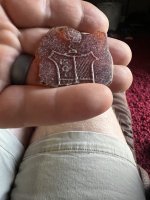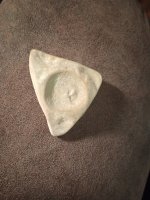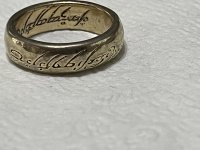GelatiMiner
Newbie
- May 6, 2013
- 2
- 0
- Detector(s) used
- Fisher Gold Bug Pro
- Primary Interest:
- All Treasure Hunting
Hi all, I'm a newbie from Australia and first time poster, I have done a lot of reading of this excellent resource and it's been truly invaluable. It helped me to choose my first gold detector - a Fisher Gold Bug Pro which I love!
Recently I spent a long weekend gold detecting around the Victorian Daylesford area which is old gold rush territory. Was hoping (ok expecting!) to find at least a sliver of gold but alas no luck. My father in law is new to detecting too and he had no luck either.
Even though we didn't find anything, it gave me ample time to begin to learn my detector and to start to question myself and my detector and what exactly I was doing. With no experience and bushcraft skills it all felt very random and whilst massively enjoyable I felt a bit lost at times to be honest. I feel I completely understand my device thanks to the excellent manual and resources such as this forum. Where I am lacking is knowing WHERE to detect. What areas are going to maximise my chances?
Here are some of the questions I was hoping some of you gurus could help with:
My Fisher Gold Bug Pro settings for pretty much the entire expedition were gain at 11 o'clock, threshold at either 11 or 12 o'clock, as per the legendary poster and Gold Bug Pro expert, Trinity AU. I liked to detect with a small constant audio tone. I was very careful to ground balance using Ground Grab often.
1. What happens to the ground phase when gold is present? Increases or decreases?
2. In hot ground should I ground balance to hot rocks?
3. What features should be detected first?
- ie old dried up creeks
- bush areas near mine shafts?
- compacted areas of soil full of rocks in places like pine forests?
- areas with lots of quartz sitting on the ground?
- areas with lots of hot rocks sitting on the ground?
- areas with highly magnetised rocks and soil?
- areas next to tree trunks?
- areas with high iron oxide readings on my detector?
4. If I am fully ground balanced, I often get a lot of subtle VCO audio cues - with no target ID in All metal or discriminated mode. Should I investigate these? In some areas I was in I would get this literally every metre or so, became ridiculous quickly.
5. If I investigate 4. and find that after taking a few inches of topsoil off I still can't get a target ID in all metal or discrimination mode, should I abandon the dig and just put it down to a particularly hot patch of soil?
6. If I do get some target id's in discrim mode, but they are weird numbers like 1 or 80 and moving around everywhere should I investigate or is this again just a hot patch of soil?
7. If target appears to move around - ie target id and VCO seem to trigger in different locations with each sweep of the detector is this a hot patch and should it be abandoned?
8. How do I know what bedrock is and do I need to find it to get gold?
9. This is the ultimate question, at what point does an audio signal and ground phase alteration warrant further investigation? I did not know what this threshold was so I had to investigate everything which was time consuming and ultimately did not turn up any gold.
Thanks for your help!
GelatiMiner
GelatiMiner's mining adventures
Recently I spent a long weekend gold detecting around the Victorian Daylesford area which is old gold rush territory. Was hoping (ok expecting!) to find at least a sliver of gold but alas no luck. My father in law is new to detecting too and he had no luck either.
Even though we didn't find anything, it gave me ample time to begin to learn my detector and to start to question myself and my detector and what exactly I was doing. With no experience and bushcraft skills it all felt very random and whilst massively enjoyable I felt a bit lost at times to be honest. I feel I completely understand my device thanks to the excellent manual and resources such as this forum. Where I am lacking is knowing WHERE to detect. What areas are going to maximise my chances?
Here are some of the questions I was hoping some of you gurus could help with:
My Fisher Gold Bug Pro settings for pretty much the entire expedition were gain at 11 o'clock, threshold at either 11 or 12 o'clock, as per the legendary poster and Gold Bug Pro expert, Trinity AU. I liked to detect with a small constant audio tone. I was very careful to ground balance using Ground Grab often.
1. What happens to the ground phase when gold is present? Increases or decreases?
2. In hot ground should I ground balance to hot rocks?
3. What features should be detected first?
- ie old dried up creeks
- bush areas near mine shafts?
- compacted areas of soil full of rocks in places like pine forests?
- areas with lots of quartz sitting on the ground?
- areas with lots of hot rocks sitting on the ground?
- areas with highly magnetised rocks and soil?
- areas next to tree trunks?
- areas with high iron oxide readings on my detector?
4. If I am fully ground balanced, I often get a lot of subtle VCO audio cues - with no target ID in All metal or discriminated mode. Should I investigate these? In some areas I was in I would get this literally every metre or so, became ridiculous quickly.
5. If I investigate 4. and find that after taking a few inches of topsoil off I still can't get a target ID in all metal or discrimination mode, should I abandon the dig and just put it down to a particularly hot patch of soil?
6. If I do get some target id's in discrim mode, but they are weird numbers like 1 or 80 and moving around everywhere should I investigate or is this again just a hot patch of soil?
7. If target appears to move around - ie target id and VCO seem to trigger in different locations with each sweep of the detector is this a hot patch and should it be abandoned?
8. How do I know what bedrock is and do I need to find it to get gold?
9. This is the ultimate question, at what point does an audio signal and ground phase alteration warrant further investigation? I did not know what this threshold was so I had to investigate everything which was time consuming and ultimately did not turn up any gold.
Thanks for your help!
GelatiMiner
GelatiMiner's mining adventures
Upvote
0







